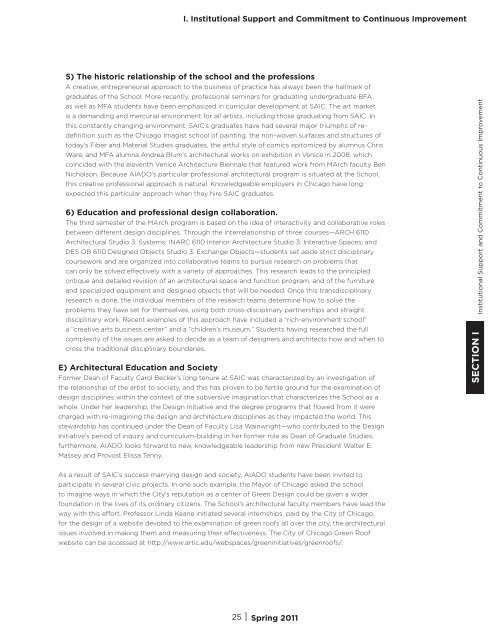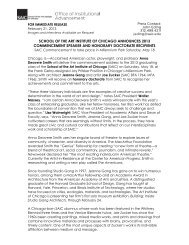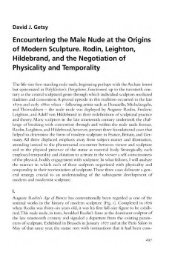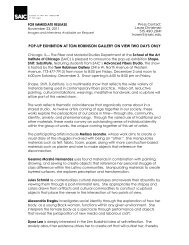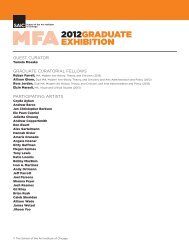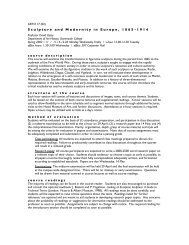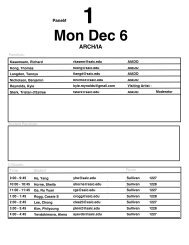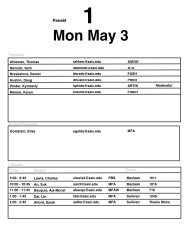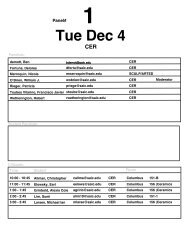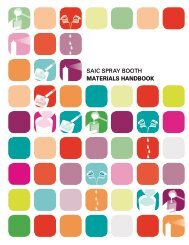i. institutional support and commitment to continuous improvement
i. institutional support and commitment to continuous improvement
i. institutional support and commitment to continuous improvement
You also want an ePaper? Increase the reach of your titles
YUMPU automatically turns print PDFs into web optimized ePapers that Google loves.
I. Institutional Support <strong>and</strong> Commitment <strong>to</strong> Continuous Improvement<br />
5) The his<strong>to</strong>ric relationship of the school <strong>and</strong> the professions<br />
A creative, entrepreneurial approach <strong>to</strong> the business of practice has always been the hallmark of<br />
graduates of the School. More recently, professional seminars for graduating undergraduate BFA<br />
as well as MFA students have been emphasized in curricular development at SAIC. The art market<br />
is a dem<strong>and</strong>ing <strong>and</strong> mercurial environment for all artists, including those graduating from SAIC. In<br />
this constantly changing environment, SAIC’s graduates have had several major triumphs of re-<br />
definition such as the Chicago Imagist school of painting, the non-woven surfaces <strong>and</strong> structures of<br />
<strong>to</strong>day’s Fiber <strong>and</strong> Material Studies graduates, the artful style of comics epi<strong>to</strong>mized by alumnus Chris<br />
Ware, <strong>and</strong> MFA alumna Andrea Blum’s architectural works on exhibition in Venice in 2008, which<br />
coincided with the eleventh Venice Architecture Biennale that featured work from MArch faculty Ben<br />
Nicholson. Because AIADO’s particular professional architectural program is situated at the School,<br />
this creative professional approach is natural. Knowledgeable employers in Chicago have long<br />
expected this particular approach when they hire SAIC graduates.<br />
6) Education <strong>and</strong> professional design collaboration.<br />
The third semester of the MArch program is based on the idea of interactivity <strong>and</strong> collaborative roles<br />
between different design disciplines. Through the interrelationship of three courses—ARCH 6110<br />
Architectural Studio 3: Systems; INARC 6110 Interior Architecture Studio 3: Interactive Spaces; <strong>and</strong><br />
DES OB 6110 Designed Objects Studio 3: Exchange Objects—students set aside strict disciplinary<br />
coursework <strong>and</strong> are organized in<strong>to</strong> collaborative teams <strong>to</strong> pursue research on problems that<br />
can only be solved effectively with a variety of approaches. This research leads <strong>to</strong> the principled<br />
critique <strong>and</strong> detailed revision of an architectural space <strong>and</strong> function program, <strong>and</strong> of the furniture<br />
<strong>and</strong> specialized equipment <strong>and</strong> designed objects that will be needed. Once this transdisciplinary<br />
research is done, the individual members of the research teams determine how <strong>to</strong> solve the<br />
problems they have set for themselves, using both cross-disciplinary partnerships <strong>and</strong> straight<br />
disciplinary work. Recent examples of this approach have included a “rich-environment school”<br />
a “creative arts business center” <strong>and</strong> a “children’s museum.” Students having researched the full<br />
complexity of the issues are asked <strong>to</strong> decide as a team of designers <strong>and</strong> architects how <strong>and</strong> when <strong>to</strong><br />
cross the traditional disciplinary boundaries.<br />
E) Architectural Education <strong>and</strong> Society<br />
Former Dean of Faculty Carol Becker’s long tenure at SAIC was characterized by an investigation of<br />
the relationship of the artist <strong>to</strong> society, <strong>and</strong> this has proven <strong>to</strong> be fertile ground for the examination of<br />
design disciplines within the context of the subversive imagination that characterizes the School as a<br />
whole. Under her leadership, the Design Initiative <strong>and</strong> the degree programs that flowed from it were<br />
charged with re-imagining the design <strong>and</strong> architecture disciplines as they impacted the world. This<br />
stewardship has continued under the Dean of Faculty Lisa Wainwright—who contributed <strong>to</strong> the Design<br />
Initiative’s period of inquiry <strong>and</strong> curriculum-building in her former role as Dean of Graduate Studies;<br />
furthermore, AIADO looks forward <strong>to</strong> new, knowledgeable leadership from new President Walter E.<br />
Massey <strong>and</strong> Provost Elissa Tenny.<br />
As a result of SAIC’s success marrying design <strong>and</strong> society, AIADO students have been invited <strong>to</strong><br />
participate in several civic projects. In one such example, the Mayor of Chicago asked the school<br />
<strong>to</strong> imagine ways in which the City’s reputation as a center of Green Design could be given a wider<br />
foundation in the lives of its ordinary citizens. The School’s architectural faculty members have lead the<br />
way with this effort. Professor Linda Keane initiated several internships, paid by the City of Chicago,<br />
for the design of a website devoted <strong>to</strong> the examination of green roofs all over the city, the architectural<br />
issues involved in making them <strong>and</strong> measuring their effectiveness. The City of Chicago Green Roof<br />
website can be accessed at http://www.artic.edu/webspaces/greeninitiatives/greenroofs/.<br />
25 | Spring 2011<br />
SECTION I Institutional Support <strong>and</strong> Commitment <strong>to</strong> Continuous Improvement


